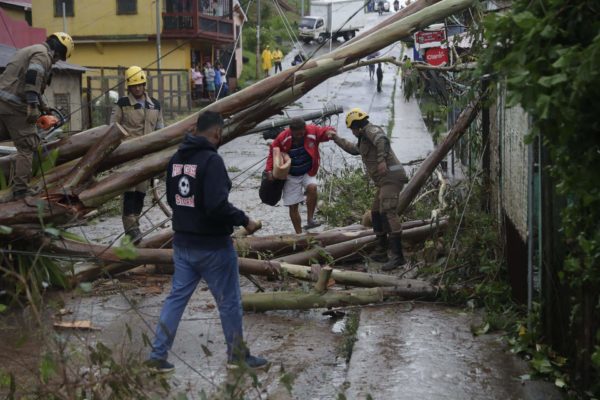Julia Left Nicaragua with more than 5,000 Homes Damaged

Local media reports two deaths after Julia’s aftermath. Rains will continue until Tuesday.
HAVANA TIMES – Hurricane Julia, which hit Nicaragua between Orinoco and Laguna de Perlas in the South Caribbean early Sunday, left the country at about 4:30 p.m., after 15 hours of crossing through the national territory, leaving more than 5,000 homes damaged throughout the country and the death of at least two people.
Citizen networks reported that Gustavo Adolfo Talavera and Sergio Leonel Luguez Figueroa, were the two people who died on Sunday, after being swept away by the currents of the Esteli and San Dionisio (Matagalpa) rivers, respectively. However, officially their deaths have not been confirmed by State authorities, who until Sunday night maintained that no human losses had been recorded as a result of the passage of Julia.
Julia leaves Nicaragua
Marcio Vaca, director of meteorology of the Nicaraguan Institute of Territorial Studies (INETER), explained that Julia, then a tropical storm, left Nicaragua through Corinto, Chinandega, towards the Pacific Ocean, keeping its travelling speed of 26 kilometers per hour (16 mph).
Already weakened, Julia moved parallel to the coasts of Chinandega and then headed towards the coasts of El Salvador and Honduras,” added Vaca.
He warned that although the storm was already out of the country and in the Pacific Ocean “it will continue to introduce a lot of moisture to the Pacific, South Central and Northern regions of Nicaragua, and with the introduction of moist air precipitations could continue on Monday and possibly even on Tuesday.
“The rains may not be significant, but the soils are saturated and these rains can be expected to become currents and flooding could be present,” he added.
Likewise, he warned that waves on Monday and Tuesday could present “surges along the Pacific Coast and these could be up to 2.7 meters high.” Therefore, he called on the population to avoid getting close to the Pacific coastal area and to be careful with landslides that could be generated by the saturation of soils due to the rain that has fallen constantly in recent hours.
Previous to the departure of Julia, the Ortega-Murillo government decreed a red alert for the entire national territory, leaving without effect the yellow alert imposed on October 8, prior to the impact of phenomenon.
In the communique “Declaration of Red Alert,” Civil Defense authorities and the Mayor’s Offices were authorized to take the necessary measures to attend the affected population. It also ordered them to execute emergency response plans in each of their territories, to maintain permanent sessions and communication, to implement search and rescue operations of the affected population, get personnel from the institutions ready for tasks in contingency plans, and guarantee the availability of resources of public and private institutions to attend the emergency.
More than 5,000 houses affected
VP Murillo said on Sunday night, that up to that moment “we have no deaths,” although, she specified that at the national level there were numerous damages, mentioning among these more than 2,000 houses destroyed and more than 3,000 damaged from flooding.
Murillo assured that the damage numbers could increase in the coming hours since a big part of the damage was yet to be reported, mentioning that up to that moment they had not been able to communicate with Laguna de Perlas.
Guillermo Gonzalez, director of the National System for the Prevention, Mitigation and Attention of Disasters (SINAPRED), detailed that together with different institutions they carried out a series of preparations that resulted in more than 600 shelters at the level of the impact zone. In addition to 900 “solidarity houses,” which allowed the mobilization of more than 13,000 people who lived in places of greater impact of Julia.
Gonzalez assured that most of the people who were sheltered during the passage of Julia, especially in the Caribbean of Nicaragua, have been returning to their homes as security conditions allow them to do so.
Damage to schools and hospitals
Reports from the Ministry of Health (MINSA), read by Murillo in the early hours of Sunday night, state that in the shelters and temporary refuge, mainly those located in the Caribbean of Nicaragua, there are “746 brothers and sisters receiving medical attention.”
At the midday report, the Sandinista spokeswoman also indicated that MINSA reported damage to roofs, windows and doors of the health units of Bluefields, Karawala, Sandy Bay, Matiguas and Walpa-Kara. However, at night she did not update in which other zones there were also damage.
At noon on Sunday, she also stated that some 164,000 families throughout the country were affected by the interruption of electric power services. She also reported that 58,000 families in the whole country were affected by drinking water services. However, both data was not updated in the report presented by Murillo in the evening.
The vice-president said that 49 schools in different departments had minor damage to their infrastructure, mainly roof detachment, falling trees and perimeter walls.
She mentioned that the National Technological Institute (INATEC) also reported minor damages in its learning centers in San Rafael del Sur, Diriamba, Managua, Ticuantepe, Boaco and Monimbo.
The rise of rivers, torrents and floods
Citizen networks reported through social networks the rise of rivers, torrents and floods in San Benito, Santo Domingo, Juigalpa, La Libertad, Teustepe, San Juan del Sur, Nandaime, Tipitapa, Dipilto, Acoyapa, Siuna, Waslala, Tola, San Marcos, Puerto Cabezas, Bilwi and Muelle de los Bueyes.
They documented that in Nandaime, Granada, a citizen was swept away in the torrents unleashed by the rains, but fortunately he was rescued alive.
Damages were also reported in the Tipitapa market due to flooding inside the market stalls. One of the galleries of the El Porvenir market of Rio Blanco, Matagalpa, lost its roof. Merchants reported through social networks that they went to the scene to try and salvage their goods.





